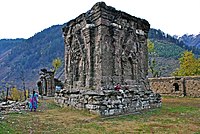কালী মন্দির, কলাত
| কালী মন্দির, কলাত کالی مندر قلات | |
|---|---|
 | |
| ধর্ম | |
| অন্তর্ভুক্তি | হিন্দুধর্ম |
| ঈশ্বর | কালী ও শিব |
| অবস্থান | |
| দেশ | পাকিস্তান |
| স্থানাঙ্ক | ২৯°০১′৪৯″ উত্তর ৬৬°৩৪′৪৮″ পূর্ব / ২৯.০৩০৪° উত্তর ৬৬.৫৮° পূর্ব |
| স্থাপত্য | |
| ধরন | উত্তর ভারতীয় স্থাপত্যশৈলী |
| বিনির্দেশ | |
| মন্দির | ১ |
| স্মৃতিস্তম্ভ | ১ |
| শিলালিপি | ২ |
কলাত কালী মন্দির (ব্রাহুই/উর্দু: کالی مندر ) হল পাকিস্তানের বেলুচিস্তান প্রদেশের কলাত শহরে অবস্থিত হিন্দু দেবী কালীর একটি মন্দির।[১]
ইতিহাস[সম্পাদনা]
কলাতের মোট জনসংখ্যার ২ শতাংশ হিন্দু।[২] এছাড়াও কিছু হিন্দু হিন্দকোওয়ান বণিক এখানে বসতি স্থাপন করেছিলেন।[৩][৪]
কলাতের কালী মন্দিরটি পূর্বতন কলাত রাজ্যের নগরদুর্গের পাদদেশে অবস্থিত। এই মন্দিরটি দক্ষিণ এশিয়ায় ইসলামের আগমনের আগেই নির্মিত হয়েছিল।
সেকালে এই মন্দিরটি কলাত-ই-সেবা (এক কিংবদন্তি হিন্দু রাজার নামানুসারে) ও কলাত-ই নিকারি (ব্রাহুই-ভাষী বালোচ নিকারি উপজাতির নামানুসারে) নামে পরিচিত ছিল। সাধারণভাবে নিকারিরাই মূলনিবাসী ব্রাহুইদের সবচেয়ে পুরনো শাখা হিসেবে স্বীকৃত।[৫]
কথিত আছে, স্থানীয় বালোচদের কিংবদন্তি নায়ক সেওয়া কলাত শহরটি প্রতিষ্ঠা করেন এবং তারই নামানুসারে এটির নামকরণ করা হয় কলাত-ই সেওয়া (সেওয়ার (কলাত (দুর্গ)|দুর্গ]])।
আরও দেখুন[সম্পাদনা]
তথ্যসূত্র[সম্পাদনা]
- ↑ Daily Times article on Varun Dev Temple
- ↑ Encyclopædia Britannica: a new survey of universal knowledge, Volume 3। Encyclopœdia Britannica। ১৯৬৪। সংগ্রহের তারিখ ২০০৮-০৮-১৭।
Almost all the people are Muslim ; the largest Hindu minorities are in the Sibi (9%) and Kalat (2%) districts.
- ↑ Viking fund publications in anthropology, Issue 43। Viking Fund। ১৯৬৬। সংগ্রহের তারিখ ২০০৮-০৮-১৭।
...is in the hands of a small caste of Hindu merchants. These Hindus are Hindko-speaking and regard Kalat as their homeland, where they generally keep their families and go for some months every year to visit and to obtain supplies. While in the Marri area, they must be under the protection of a local Marri chief or the sardar himself.
- ↑ The social organization of the Marri Baluch। Indus Publications। ১৯৬৬। সংগ্রহের তারিখ ২০০৮-০৮-১৭।
...is in the hands of a small caste of Hindu merchants. These Hindus are Hindko-speaking and regard Kalat as their homeland, where they generally keep their families and go for some months every year to visit and to obtain supplies. While in the Marri area, they must be under the protection of a local Marri chief or the sardar himself.
- ↑ E.J. Brill's first encyclopaedia of Islam, 1913-1936, Volume 4 By M. Th. Houtsma, Martijn Theodoor Houtsma Page 678; Quote: “It has been known in earlier times as Kalat-i-Seva (from a legendary Hindu king) and Kalat-i Nicari which connects it with the Brahui Speaking Baloch tribe of Nicari , which is generally accepted as belonging to the oldest branch of the indigenous Brahois.”


